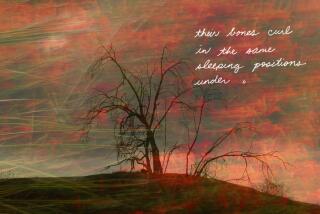BOOKS TO GO
- Share via
Steps toward his English roots
Walking to CanterburyWalking to Canterbury
A Modern Journey Through Chaucer’s Medieval England
Jerry Ellis
Ballantine Books: 336 pp., $14.95 paper
About 600 years after Geoffrey Chaucer spun his tale of pilgrims talking and traipsing their way from London east to Canterbury, here comes an American -- and part Cherokee at that -- to walk in those footsteps.
Jerry Ellis took this 60-mile trip in 1999 to see what has changed and what hasn’t about England, to explore the half of his heritage that goes back to Britain, to meditate on faith and, best of all, to get the locals talking, by turns plainly, playfully and profoundly. The result is flawed but memorable.
Ellis gives an updated view of the landmark at the end of the road: Canterbury Cathedral, where Archbishop Thomas a Becket was murdered in 1170, beginning a tradition of pilgrimage that Chaucer seized upon two centuries later.
There’s Claire, a Frenchwoman who demonstrates her impassioned politics and imperfect English in an encounter on the grounds of a 15th century Carmelite monastery.
“You Americans are only 4% of the world, but you use 25% of all energy,” she tells him. “How can you be so thoughtful?”
Then there are others -- the monk who loves Steve McQueen movies, the Dutch spiritual dabbler who goes by Geronimo and a gang of miscreant but engaging youths. Charmed by Ellis’ open manner and his pilgrim’s hat, they take the 50-ish author under their wing and introduce him, by an entertaining and trust-testing blindfold stunt, to their pet iguana.
To some degree this book is a natural for Ellis, whose previous volumes include “Walking the Trail: One Man’s Journey Along the Cherokee Trail of Tears” and “Marching Through Georgia: My Walk Along Sherman’s Route.” (I interviewed him in 1996, when he was traveling the country to research a manuscript about spiritually significant Native American sites.)
The great strength of the new book is the author’s ability to quickly and deeply engage those who cross his path.
Often it’s Ellis’ hat or his disclosure of his mission that at first helps draw these strangers out. But it’s his open mind and willingness to wear his heart on his sleeve that coax out the most remarkable confidences. (Given those disclosures, it isn’t surprising to find an author’s note in which Ellis acknowledges that he has changed some names and details.)
Some of his gleanings from medieval history are intriguing, such as his details of such terms as “loophole” and “busy bee.”
But there are problems too. In his eagerness to juxtapose Chaucer’s era with our own, Ellis often winds up lurching awkwardly between details of the 14th century and modern times. Also, in the heat of so many openhearted moments, he does slide occasionally into deep sentimentality and frequently into that middle kingdom of prose that warms some readers’ hearts while annoying others.
In that category, for instance, I’d put this sentence about an artist with whom he shares a brief but intimate encounter:
“When she looked at me again, her soul seemed as naked as we all sometimes see our own in the frightening honesty of late-night mirrors.”
*
A guide to the
Thames River
River ThamesRiver Thames
In the Footsteps of the Famous
Paul Goldsack
Bradt Travel Guides, Globe Pequot Press: 232 pp., $18.95 paper
Not far from the pilgrims’ path between London and Canterbury, the Thames twists and turns on its east-west route. This guide, the first I’ve seen devoted to the attractive idea of building an itinerary around the river, features detailed maps, handsome sketches and myriad historical footnotes.
It does lack lodging information. Still, whether for walkers, drivers, cyclists, boaters or even travelers by bus or train, this looks like an excellent aid to finding your way along the 180-mile-or-so Thames Path. The route runs between the river’s source near Cirencester, west of Oxford, and the Thames Barrier, the safeguard against flooding that stands east of London, near the longtime maritime center of Greenwich.
The author is happy to share opinions: The visitor center at the Thames Barrier, he reports, “is a tatty thing and a sore disappointment, and hardly worth the entrance cost of [about $1.60] for adults.” (Though this edition is intended for American readers, the editors haven’t bothered translating British pounds into dollars.)
*
Pulling back
Cuba’s curtain
Cuba on the VergeCuba on the Verge
An Island in Transition
Edited by Terry McCoy
Bulfinch Press: 200 pp., $50
This 75-image coffee-table collection of photos and essays is all about glimpses. It includes Russell Banks, Cristina Garcia and Susan Orlean among its 15 essayists (with an introduction by novelist William Kennedy), and Sylvia Plachy and Carrie Mae Weems among its 15 photographers. Pictures vary, including evocative shots of blotchy walls (with overtones of Rothko canvases) and a brief, fond Orlean portrait of the oxen team that pulls the plow of Umberto Quesada through fields outside Cienfuegos. Most memorable is the wise, sharply drawn epilogue by Arthur Miller, who describes an island junket in 2000 by a group of American culturati (himself, William Styron and Gabriel Garcia Marquez among them), who end up dining with Fidel Castro.
Christopher Reynolds’ books column appears twice a month.
More to Read
Sign up for our Book Club newsletter
Get the latest news, events and more from the Los Angeles Times Book Club, and help us get L.A. reading and talking.
You may occasionally receive promotional content from the Los Angeles Times.







